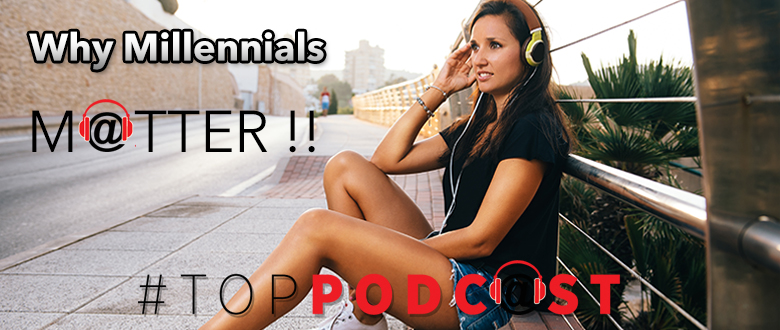A study last summer by Music Business Association concluded, not surprisingly, that Millennials listen to less radio than the generations that came before them. This is hardly news to most of us that understand consumption habits of millennials or have been swimming in a digital pool for the last 5 years.
More recently, a snap analysis of the 2017 Infinite Dial Report shows that 87% of those aged 12-24 are listening online now. That’s 87% my friends. If this number doesn’t tell you something about where we are headed, I don’t know what will.
While statistics are no doubt purveyors of what the future holds, the Music Business Association study last summer also said:
In lieu of radio, younger millennials have turned their ears and their attention to streaming, with many of those polled opting for on-demand options. This shows that not only is streaming in general more favorable, but the idea of radio simply isn’t as appealing to younger music lovers as it used to be for their older siblings, parents, and grandparents.
How Does This Correlate To Podcasts?
It’s all about smartphones and connected devices. It’s now confirmed (Edison Research) that 81% of all Americans use smartphones. When you look at millennials, that number explodes:
- Ages 12-24: 95% smartphone ownership
- Ages 25-54: 89% smartphone ownership
Why this matters?
Accessibility and discovery of podcasts has correlated to the smartphone explosion. On-demand audio is simply a ‘point-and-click’ away. In addition, while Millennials are listening to less traditional radio, they are listening online via streaming services, specifically Pandora, Spotify, iHeartRadio, and Apple Music.
In a similar study conducted by comScore, millennials are 44 percent more likely to listen to podcasts once a week on their smartphone than the average smartphone-owning adult. And the popularity does not stop with this demographic — 18-34 year olds are going to be more likely to be podcast listeners than the general population, while 12-17 year olds are almost twice as likely to listen to podcasts.
What kind of programming are they listening to?
A fascinating aspect of Millennial podcast listeners is diving into what type of podcasts they are listening to. Interestingly enough, they are primarily listening to spoken-word programming…the same type of programming that is broadcasted on stations regulated to the AM dial. This data should hearten some radio execs as they literally have this content at their fingertips. But it comes down to their distribution strategy, and allowing the content to be packaged in a way that aligns to changing consumption habits.
Why are podcasts so attractive to the younger generations?
It could simply be that the younger generations are that much more attached to their devices. And if the content is worthy enough to be ‘discovered’ on their device, it must be worthy of their attention. It could also be the increased importance surrounding on-demand content. Younger generations want to listen on their own terms…when they want it…and where they want it. Bottom line, it takes a strategy to make sure this content is available & packaged to millenials. Radio execs mustn’t underestimate a clear, cohesive strategy in packaging curated content via an on-demand platform. Bottom line, the podcast medium is a vehicle of choice for powerful distribution.
Sharing is caring – enter the Social Media factor
One of the most overlooked aspects, when it comes to on-demand discovery & consumption, is being able to share content…a fact that can’t be overlooked when it comes to analyzing a younger demographic. Millennials love to share, but they also like to like what others are sharing too. This is one of the reasons our Podfluencers will drive awareness of what is relevant in the industry, encouraging others to listen to new suggested podcasts.
Podcasts allow millenials to listen and share content with their friends. The social media impact is a key driver to podcast consumption, aligning seamlessly with millenials.
You can’t just share any old content and expect to be successful. In order to appeal to the younger demographic, you have to offer appealing content in a format that this age group prefers to consume. While broadcast radio assumes that Millennials want to hear the latest hits, they often overlook that they also want to hear original non-fiction programming.
While broadcast radio assumes that Millennials want to hear the latest hits, they often overlook that they also want to hear original non-fiction programming.
The podcast publishers that are experiencing the most success are the ones that have embraced this fact and are finding ways to tap into the power of the millennial masses.
Radio Can’t Rely on False Assumptions
While broadcast radio assumes that Millennials want to hear the latest hits, they overlook that they also want to hear original non-fiction programming. Old-school radio execs, in the past, have underestimated the power of the millennial and changing consumption habits.
Previously relying too heavily on an ‘in-the-now’ strategy that focused more company resources on PPM, (Portable People Meters), song survey analyses, format changes, radio transmission fees, and program directors that lacked flexibility, it’s time to jump on a new vision that aligns with millennials…or trust me, history will repeat itself…and you’ll go the way of MySpace, Friendster, and your Blackberry.
To steal a line from an old ‘Friend’ in the radio biz…
“It’s a great day to be in radio”…that is, if you accept and invest in the future of on-demand audio, aggressively monetizing your streaming platform, and align with the consumption habits of the future (they live on mobile). PS – the future is here.
Editorial Note: Stats in this article came from Forbes as well as the 2017 Infinite Dial Report, as noted above.

 Our TOPPODCAST Picks
Our TOPPODCAST Picks  Stay Connected
Stay Connected